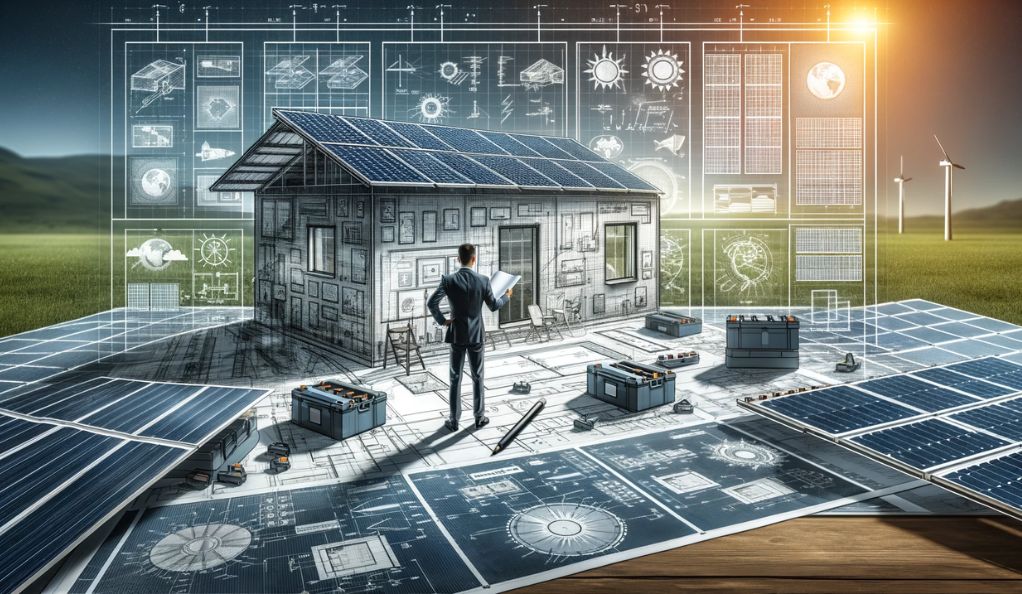The allure of energy independence and the pursuit of a sustainable lifestyle have led many to explore the world of off-grid solar systems. This section aims to demystify the basics of off-grid solar energy and highlight its benefits, providing a foundation for those considering a transition to this renewable energy source.

Understanding the Basics
An off-grid solar system is essentially a standalone power system, not connected to the main electricity grid. It relies entirely on solar panels to capture energy from the sun, which is then converted into electrical power to run household appliances and lighting. The key components of such a system include solar panels, a battery bank for energy storage, a charge controller to regulate the charging of batteries, and an inverter to convert direct current (DC) from the panels and batteries into alternating current (AC) used by most home appliances.
The capacity and size of an off-grid solar system vary depending on individual energy needs and geographical location, which affects the amount of sunlight available. The system must be carefully designed to ensure it can provide enough power throughout the year, considering seasonal variations in sunlight.
Benefits of Going Off-Grid
- Energy Independence: One of the most compelling reasons for adopting an off-grid solar system is the independence it provides. You are no longer reliant on the public electricity grid, which can be particularly advantageous in remote or rural areas where grid electricity is unreliable or unavailable.
- Environmental Impact: Solar energy is a clean, renewable resource. By using solar power, you reduce your carbon footprint, contributing to the fight against climate change. Off-grid systems do not emit greenhouse gases during operation, making them environmentally friendly.
- Reduced Electricity Costs: Over time, an off-grid solar system can be financially beneficial. While the initial setup cost may be substantial, the ongoing savings on electricity bills and the low maintenance costs can make it a cost-effective solution in the long run.
- Self-Sufficiency: Off-grid living encourages a self-sufficient lifestyle. It fosters an understanding and appreciation of energy consumption, leading to more mindful and efficient usage patterns.
- Technological Advances: Advances in solar technology and battery storage have made off-grid systems more efficient and reliable. Modern systems can store enough energy to power homes even during periods of low sunlight.
- Incentives and Rebates: Many regions offer incentives, rebates, or tax breaks for installing solar power systems, making the transition more affordable.
Planning Your Off-Grid Solar System
The journey to a successful DIY off-grid solar system begins with meticulous planning. This phase is crucial as it lays the groundwork for your system’s efficiency, reliability, and sufficiency in meeting your energy needs.
Assessing Energy Needs and Consumption Patterns
The first step in planning is to understand and calculate your daily energy usage. This involves listing all electrical appliances and devices in your household and noting their power requirements (usually in watts). Remember to consider the frequency and duration of each item’s use to get a more accurate picture of your energy consumption.
It’s important to factor in seasonal variations in energy usage. For instance, heating systems may be used more in the winter, while air conditioning might be predominant in summer. These variations will impact the sizing of your solar system.
Calculating Solar Panel Requirements
The amount of energy your solar panels need to produce depends directly on your calculated energy needs. However, the efficiency of solar panels is not 100%, and geographic location plays a significant role in their energy production capacity.
To estimate the number of solar panels required, you’ll need to consider the peak sun hours in your location. Peak sun hours refer to the average number of hours in a day when the sunlight intensity is high enough to be considered optimal for solar energy production.
Using solar irradiance maps or local meteorological data can provide insights into the average peak sun hours in your region. You can then use these figures to approximate the total solar panel output required to meet your daily energy consumption.
Selecting the Right Location for Solar Panels
The effectiveness of solar panels is heavily influenced by their placement. For optimal performance, panels should be installed in a location with maximum sun exposure, minimal shading, and proper angling towards the sun.
Roof-mounted panels are a common choice, but ground-mounted systems can be more accessible for maintenance and adjustable for optimal sun exposure. The direction and tilt of the panels should correspond to your geographic location. In the Northern Hemisphere, for example, solar panels should typically face south.
Components of an Off-Grid Solar System
After planning and understanding your energy requirements, the next crucial step is selecting the right components for your off-grid solar system. Each component plays a vital role in the system’s overall performance.
Solar Panels: Types and Selection
Solar panels come in various types, mainly monocrystalline, polycrystalline, and thin-film. Monocrystalline panels, recognized by their dark color and uniform look, are known for high efficiency and durability but come at a higher cost. Polycrystalline panels, with their blue hue and speckled appearance, offer a balance of efficiency and affordability. Thin-film panels are flexible and lightweight but generally less efficient than their crystalline counterparts.
The choice between these types depends on your budget, space availability, and the specific energy requirements of your off-grid system.
Batteries: Lithium-ion vs. Lead-acid
Batteries are essential for storing the energy generated by your solar panels. The most common types are lithium-ion and lead-acid batteries. Lithium-ion batteries are preferred for their longer lifespan, higher depth of discharge, and minimal maintenance, albeit at a higher upfront cost. Lead-acid batteries, while cheaper, offer less energy density and require more maintenance.
Charge Controllers: PWM vs. MPPT
Charge controllers protect your batteries from being overcharged by regulating the voltage and current coming from the solar panels. PWM (Pulse Width Modulation) controllers are simpler and more cost-effective but less efficient. MPPT (Maximum Power Point Tracking) controllers, although more expensive, optimize the power output from the panels, making them suitable for larger systems.
Off-Grid Inverters and Their Importance
Inverters play a crucial role in converting the DC power from your solar panels and batteries into AC power, which is used by most household appliances. The inverter’s capacity should match the total power consumption of your appliances and the output of your solar array. It’s essential to choose an inverter with a suitable peak power rating and continuous output power to ensure reliable operation of your appliances.
Designing and Sizing Your System
Once the components of your off-grid solar system are selected, the next critical step is to design and size the system appropriately. This ensures that the system will be capable of meeting your energy needs efficiently.

Determining System Voltage and Battery Size
The system voltage for off-grid solar setups typically ranges between 12V, 24V, and 48V. The choice of system voltage affects both the solar panels and the batteries. A higher voltage system can be more efficient and allows for longer cable runs without significant power loss. When sizing the battery bank, consider your energy consumption needs and the autonomy days (days the system can run without sunlight).
The battery size should be large enough to store sufficient energy to cover your needs, especially during periods with less sunlight. It’s crucial to consider factors like the depth of discharge (DoD) of the batteries, which represents how much of the battery’s energy can be used before recharging.
Understanding Depth of Discharge
The Depth of Discharge is a critical factor in battery sizing and longevity. For instance, lithium-ion batteries often allow a higher DoD compared to lead-acid batteries. Using a larger portion of the battery capacity without compromising its lifespan is essential for optimizing system performance.
Importance of Efficiency and Power Loss Considerations
System efficiency is key in off-grid solar systems. Efficiency losses can occur at various stages, including power conversion in the inverter, transmission losses in cables, and power regulation in charge controllers. Minimizing these losses is essential for maximizing the overall efficiency of the solar system.
Installation Process
Installing an off-grid solar system involves several steps that must be executed with precision and safety in mind. Proper installation ensures the system’s optimal performance and longevity.
Preparing for Installation
Before beginning the installation, ensure that all components are compatible and that you have the necessary tools and safety equipment. Understanding the layout and wiring requirements of the system is crucial. It’s often beneficial to draw a diagram of the system setup.
Wiring Solar Panels: Series vs. Parallel
Solar panels can be connected in series to increase the voltage or in parallel to increase the current. The choice depends on the system voltage and the characteristics of the charge controller and inverter. In a series connection, the voltage adds up, while the current stays constant. In parallel, the current adds up, while the voltage remains the same as that of a single panel.
Setting Up the Charge Controller and Inverter
The charge controller should be connected between the solar panels and the batteries to regulate the charging process and protect the batteries from overcharging. The inverter, which converts DC power to AC, should be connected to the battery bank. It’s crucial to follow the manufacturer’s instructions and safety guidelines during these installations.
Safety Considerations and Tips
Safety is paramount when installing an off-grid solar system. Always follow electrical safety practices, use appropriate personal protective equipment, and ensure that all connections are secure and correctly insulated. It’s advisable to install safety disconnects and circuit breakers to protect the system and its users.
Maintenance and Troubleshooting
A well-maintained off-grid solar system can provide years of reliable service. Regular maintenance is essential to ensure the system operates efficiently and to prevent potential issues.
Regular Maintenance Tips for Longevity
Regularly check and clean solar panels, inspect batteries for signs of wear or damage, and ensure all connections are tight and corrosion-free. It’s also important to monitor the system’s performance and check the charge controller and inverter settings periodically.
Common Issues and Troubleshooting Techniques
Some common issues in off-grid solar systems include reduced power output, battery charging problems, and inverter faults. Keeping a log of system performance can help in identifying trends that may indicate a problem. When troubleshooting, always start with the simplest checks, like ensuring all connections are secure and components are not visibly damaged.
Upgrading and Expanding Your System
As your energy needs evolve, your off-grid solar system may require upgrades or expansion. Adding more solar panels, increasing battery capacity, or upgrading to a more efficient inverter are common ways to enhance your system. Ensure that any additions are compatible with the existing setup and recalibrate the system accordingly.
Conclusion
In conclusion, embarking on a DIY off-grid solar system project is a transformative journey towards energy independence and environmental stewardship. This comprehensive guide has outlined the critical steps of planning, component selection, system design, installation, and maintenance. By meticulously following these guidelines, homeowners can efficiently harness solar energy, ensuring a reliable and sustainable power source. Embrace this eco-friendly path, and join the growing community committed to renewable energy and a greener future.
